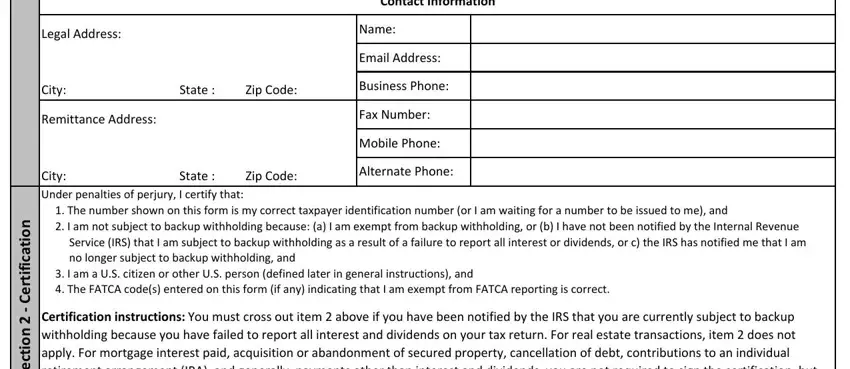|
General Instructions |
|
|
Nonresident alien who becomes a resident alien. |
|
|
|
|
|
Generally, only a nonresident alien individual may |
|
Section references are to the Internal Revenue Code |
use the terms of a tax treaty to reduce or eliminate |
|
unless otherwise noted. |
|
|
U.S. tax on certain types of income. However, most |
|
|
|
|
|
Future developments. The IRS has created a page |
tax treaties contain a provision known as a “saving |
|
clause.” Exceptions specified in the saving clause |
|
on IRS.gov for information about Form W-9, at |
|
may permit an exemption from tax to continue for |
|
www.irs.gov/w9. Information about any future |
|
certain types of income even after the payee has |
|
developments affecting Form W-9 (such as |
|
otherwise become a U.S. resident alien for tax |
|
legislation enacted after we release it) will be |
|
purposes. |
|
posted on that page. |
|
|
|
|
|
|
|
Purpose of Form |
|
|
If you are a U.S. resident alien who is relying on an |
|
|
|
exception contained in the saving clause of a tax |
|
A person who is required to file an information |
|
treaty to claim an exemption from U.S. tax on |
|
return with the IRS must obtain your correct |
|
certain types of income, you must attach a |
|
taxpayer identification number (TIN) to report, for |
|
statement to Form W-9 that specifies the following |
|
example, income paid to you, payments made to |
|
five items: |
|
you in settlement of payment card and third party |
|
1. The treaty country. Generally, this must be the |
|
network transactions, real estate transactions, |
|
same treaty under which you claimed exemption |
|
mortgage interest you paid, acquisition or |
|
from tax as a nonresident alien. |
|
abandonment of secured property, cancellation of |
|
2. The treaty article addressing the income. |
|
debt, or contributions you made to an IRA. |
|
3. The article number (or location) in the tax treaty |
|
Use Form W-9 only if you are a U.S. person |
|
that contains the saving clause and its exceptions. |
|
(including a resident alien), to provide your correct |
|
4. The type and amount of income that qualifies for |
|
TIN to the person requesting it (the requester) and, |
|
the exemption from tax. |
|
when applicable, to: |
|
|
5. Sufficient facts to justify the exemption from tax |
|
1. Certify that the TIN you are giving is correct (or |
|
under the terms of the treaty article. |
|
you are waiting for a number to be issued), |
|
|
|
2. Certify that you are not subject to backup |
Example. Article 20 of the U.S.-China income tax |
|
|
|
withholding, or |
|
|
treaty allows an exemption from tax for scholarship |
|
|
|
|
|
3. Claim exemption from backup withholding if you |
income received by a Chinese student temporarily |
|
|
|
are a U.S. exempt payee. If applicable, you are also |
present in the United States. Under U.S. law, this |
|
|
|
certifying that as a U.S. person, your allocable share |
student will become a resident alien for tax |
|
of any partnership income from a U.S. trade or |
purposes if his or her stay in the United States |
|
|
|
business is not subject to the withholding tax on |
exceeds 5 calendar years. However, paragraph 2 of |
|
|
|
foreign partners’ share of effectively connected |
the first Protocol to the U.S.-China treaty (dated |
|
|
|
income, and |
|
|
April 30, 1984) allows the provisions of Article 20 to |
|
|
|
|
|
4. Certify that FATCA code(s) entered on this form |
continue to apply even after the Chinese student |
|
|
|
(if any) indicating that you are exempt from the |
becomes a resident alien of the United States. A |
|
|
|
FATCA reporting, is correct. |
|
|
Chinese student who qualifies for this exception |
|
|
|
|
|
Definition of a U.S. person. For federal tax |
(under paragraph 2 of the first protocol) and is |
|
relying on this exception to claim an exemption |
|
purposes, you are considered a U.S. person if you |
|
from tax on his or her scholarship or fellowship |
|
are: |
|
|
|
|
|
|
|
income would attach to Form W-9 a statement that |
|
•#$ #i |
di idual# ho#is#a#ィ.~.# itize |
#or#ィ.~.#reside t# |
|
includes the information described above to |
|
alien, |
|
|
|
support that exemption. |
|
•#$#part ership,# orporatio ,# o |
|
pa ,#or# |
|
|
|
|
associatio # reated#or#orga ized#i |
#the#ィ ited# |
If you are a nonresident alien or a foreign entity, |
|
States or under the laws of the United States, |
give the requester the appropriate completed Form |
|
|
|
•#$ #estate# other#tha #a#foreig |
#estate ,#or# |
W-8 or Form 8233. |
|
•#$#do |
esti #trust# as#defi ed#i |
#zegulatio s#se tio |
# What is backup withholding? Persons making |
|
301.7701-7). |
|
|
certain payments to you must under certain |
|
|
|
|
|
|
Foreign person. If you are a foreign person or the |
conditions withhold and pay to the IRS a percentage |
|
|
|
U.S. branch of a foreign bank that has elected to be |
of such payments. This is called “backup |
|
treated as a U.S. person, do not use Form W-9. |
withholding.” Payments that may be subject to |
|
|






